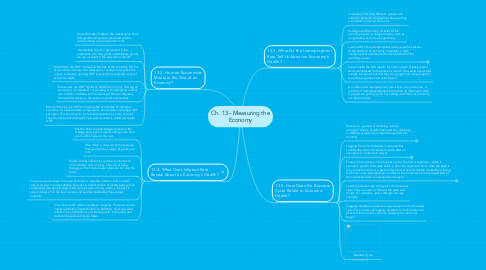Ch. 13-- Measuring the Economy
by Josie Krupich


1. 13.2- How do Economists Measure the Size of an Economy?
1.1. Gross Domestic Product: the market value of all final goods and services produced within a country during a given period of time
1.2. Intermediate Good: a good used in the production of a final good; intermediate goods are not included in the calculation of GDP
1.3. Economists use GDP to measure the size of the economy. GDP is an economic indicator that measures a country’s total economic output. A steadily growing GDP is generally considered a sign of economic health.
1.4. Economists use GDP figures to determine not only how big an economy is, but whether it is growing or shrinking and at what rate. Inflation interferes with calculating GDP over the years because that drives up the prices on good and services.
1.5. Economists also use GDP to compare the economies of individual countries. To make accurate comparisons, economists must adjust GDP yet again. This time they do so to take population size into account. They do this by calculating GDP per person which is called per capita GDP.
2. 13.4- What Does Inflation Rate Reveal About an Economy's Health?
2.1. Inflation Rate: the percentage increase in the average price level of goods and services from one month or year to the next.
2.2. Price Index: a measure of the average change in price of a type of good over time
2.3. The BLS tracks inflation by gathering information on Americans’ cost of living. The cost of living changes all the time because prices do not stay the same.
2.4. The price a person pays for a pair of shoes or any other product is its nominal cost, or its cost in current dollars. The cost in current dollars of all the basic goods and services that people need is the nominal cost of living, which is the cost in current dollars of all the basic goods and services needed by the average consumer.
2.5. In our real world, prices are always changing. The result can be creeping inflation, hyperinflation, or deflation. You know what inflation is but deflation is just the opposite. Consumers like deflation because prices go down.
3. 13.3- What Do the Unemployment Rate Tell Us About an Economy's Health?
3.1. Involuntary Part-Time Workers: people who settle for part-time employment because they are unable to find full-time work
3.2. Underground Economy: a sector of the economy based on illegal activities, such as drug dealing and unlawful gambling
3.3. Like the GDP, the unemployment rate is a useful indicator of the health of an economy. In general, a high unemployment rate means the overall health of the economy is poor.
3.3.1. Included
3.3.2. Included
3.3.3. Excluded
3.4. Every month, the BLS reports the total number of people who were unemployed for the previous month. They send out a small sample survey and but that they can gauge how many people in the entire population are unemployed.
3.5. A problem with unemployment rate is that at any one time, a number of unemployed people have given up looking for work. If people are giving up and not finding work then out economy can become poor.
4. 13.5- How Does the Business Cycle Relate to Economic Health?
4.1. Recession: a period of declining national economic activity, usually measured as a decrease in GDP for at least two consecutive quarters (six months)
4.1.1. Dependencies
4.1.2. Milestones
4.2. Lagging Economic Indicators: measures that consistently rise or fall several months after an expansion or contraction begins
4.2.1. Schedule
4.2.2. Budget
4.3. There are four phases in the business cycle. The first is expansion, which is economic growth, then peak which is when the expansion ends. After the peak is the contraction which is a period of general economic decline marked by a falling GDP and rising unemployment, and last is the trough which is the lowest part of the contraction and a new expansion begins.
4.3.1. KPI's
